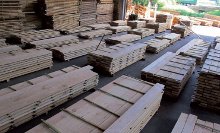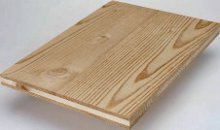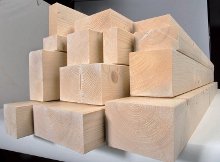Down but not out
29 November 2012Raw material prices weigh heavily on German and Austrian mills but there is hope of growing value-added products sales to the UK. Stephen Powney reports
Volumes of German softwood to the UK have been on a downward trend this year.
Official statistics show German sawn softwood timber exports to the UK were down 33.8% to 84,386m3 in January-June, while planed exports grew 31.9% to 85,642m3. This actually made the UK Germany's third biggest planed timber export market.
Timber Trade Federation statistics for January-August show Germany has a 6% market share of the UK's imported softwood market, down 14% on 2011.
According to industry organisation Wood Germany, from January-June German beech exports to the UK suffered a 31.3% reverse, while chipboard exports were up 2.4%.
Meanwhile, in Austria, sawn timber exports to the UK in the first half of 2012 were 18,478m3, well down on the 29,400m3 recorded a year ago.
High log prices coupled with a more competitive UK domestic and Nordic sawmilling sector have made the German and Austrian sawn product less attractive for UK importers.
The rate of attrition among German sawmills is high, with numerous plants closing and an estimated 1 million m3 of production capacity lost in southern Germany in 2012.
"There are more mills in trouble than mills without problems," said Wolf-Christian Kuspert, managing director of Gelo Holzwerke. "The bigger the mills, the bigger the problems.
"The forest owners don't understand the mills' problems," he said. "The log prices are still rising; it's ridiculous."
Meanwhile, Mr Kuspert is investing time in Bavarian politics, networking and lobbying in an effort to try to bring change.
He's not the only one. Germany's two largest sawmilling federations - the BSHD and VDS - are merging in January to create a bigger industry voice to tackle the multiple challenges (see p10), which also include "excessive" forest conservation and biomass.
Lawrence Webster, UK sales director of timber agency Kullik & Rullmann, said mills represented by Kullik had cut back production by 30% on average over the last 12 months.
"The sawmills are reluctant to sell wood because every time they do they are losing money. The big mills [like Klausner, Ilim Timber Europe and Klenk] have reduced their volumes considerably on the UK market. They can't compete against UK domestic carcassing or Swedish or Irish timber on price," he said.
"All the mills are restructuring. The mills that are strong are the ones that have money behind them or have their own forestry operations. There will be more sawmills that close, I am sure."
Mr Webster said Kullik's UK-bound products from Germany and Austria were generally more value-added - CLS, laminated products, scantling board and pine blanks for decking production.
Meanwhile, the German domestic market is giving some solace - and a better return - for medium-sized family-run mills.
Some sawmills are looking at opportunities to put mills into Russia because of the raw material there, while the improving US housing market is making the larger mills look stateside.
"German mills are not far away from starting to sell to the US again. The price of 2x4 there is improving all the time and they buy a lower quality CLS than Europe," added Mr Webster.
Slava Bychkov, managing director (communications) at Ilim Timber Industry, which runs two large German sawmills - the former Klausner mills at Wismar and Landsberg - admitted that the American market had "grown up" in 2012.
"The industry is becoming more and more global," said Mr Bychkov. "The US and China are the two beating hearts at the moment. I believe that the development of the recovery in the US economy and development in China will significantly affect the future stream of lumber exports."
He said the company's operations in Germany were profitable. "We are running at full capacity at Wismar on four shifts. At Landsberg we're running two-and-a-half shifts which is close to a high level of capacity utilisation."
Mr Bychkov said the Wismar mill was sourcing logs from the Baltic Sea region, as well as Germany, while the Landsberg mill had a log supply contract in place with the state forest authority, and was also buying from smaller independent forest owners.
"This allows us to run business at such a level to maintain our cost structure."
He said Ilim's UK volumes had declined, with estimated volumes in 2012 of about 25,000-30,000m3.
Not all product volumes to the UK have been declining - Gelo, which has just received FSC chain of custody certification, has seen an upsurge in its sales of KVH - finger-jointed, dried construction timber.
"There have been quite a lot of KVH sales this year, which is amazing," added Mr Kuspert.
Gelo's largest UK customer for KVH has increased its orders by 600% in 2012 to 700m3.
And on the hardwood side, Holz Schnatmeier has seen UK volumes pick up during the summer after a tough start to the year.
"Now we are finding English business is picking up," said director Petra Schnatmeier, leaving her wondering if the UK economy was improving.
"Our oak exports to England are mostly green oak beams and some air-dried beams to oak framing companies," she said. Square-edged boards are the other main product supplied.
Holz Schnatmeier supplies KVH to the domestic market and believes the product "will conquer the UK market".
That's something the KVH Monitoring Organisation is certainly hoping will happen. One of the barriers to increased use of the product in the UK has been a false perception of the safety of finger-jointing. But with tests showing finger-joints are stronger than the timber itself, coupled with the harmonisation of product standards for finger-jointed timber, the KVH Monitoring Organisation is hopeful of increased KVH sales all over Europe.
It has revised its technical brochure on KVH, Duo and Trio (laminated beams) products on the basis of DIN EN 1995-1-1 (Eurocode 5-1- 1).
The latest principles for dimensioning, based on DIN EN 1995-1-1 (Eurocode 5-1-1) are described in detail and presented in reference calculations and tables. Tenders, technical standards, quality, marking and the advantages of the products are also covered.
Product approval number Z-9.1-440 for Duo and Trio beams has also been extended and revised to account for Eurocode 5.
Since June, Duo beams can be produced with a finger-joint across the full width of the cross-section, enabling the beams to be produced in longer lengths.
UK focus
The organisation launched a UK-focused website www.finger-jointed-timber.com at the end of 2011.
"We have strong quality control in Germany and we have not had any problems in finger-jointing over the last few years," said Tobias Weigand, KVH Monitoring Organisation managing director.
Another product area being pushed in the UK by Austrian company Tilly Holzindustrie is solid wood panels, a little known product on these shores.
Basically, these three- and five-layer panels (19-52mm thicknesses) are the smaller brothers of the cross-laminated timber construction panels being used to build medium-rise apartment developments.
Aimed at the furniture, joinery, interior design and cladding sectors, the panels come in a large range of options and species.
Tilly exhibited at this year's Timber Expo in Coventry and has recruited former Westco operations director Markus Burkhardt as its UK business development manager. A UK-focused website is about to launch.
Tilly is hoping to tie up a deal soon with a major UK timber product distributor.
Mr Burkhardt believes the rise of the engineered wood flooring sector provides a marker for solid wood panels to follow.
"Engineered flooring is better quality than laminate flooring and easier to lay and I'm sure we will have the same pattern with this kind of product," he said.
Products expected to be popular in the UK include three-layer boards in spruce, Douglas fir and antique spruce. A range of hardwood panels include oak, beech and cherry.
Tilly's standard sizes are big - 2.05x5m - though it will cut smaller for volume orders.
Quoted benefits include stability, a ready decorative natural surface, relative lightness (500kg/m3) and quick installation over large areas. Applications include ceiling panels, flooring, shopfitting, wall panels and exterior cladding. Its main competitors are HDF and MDF panels.
"There is a market for this product here. I believe there is high potential," said Mr Burkhardt.
Another Austrian company - FN Neuhofer Holz - is embracing the iPad and iPhone App world to help people come up with original designs for their interior wood profiles, such as skirtings.
The wood profile manufacturer and accessories supplier has launched its FN Digiprint configurator App which allows users to take a photo of a room and drag digital printed profile designs onto the photo to visualise a change of design.
Neuhofer has invested in its own digital printing plant to allow literally any design or photo to be printed onto skirtings, flooring profiles and panels.
Neuhofer products can be sourced in the UK from Westco, QA Products and Parker Wade.



